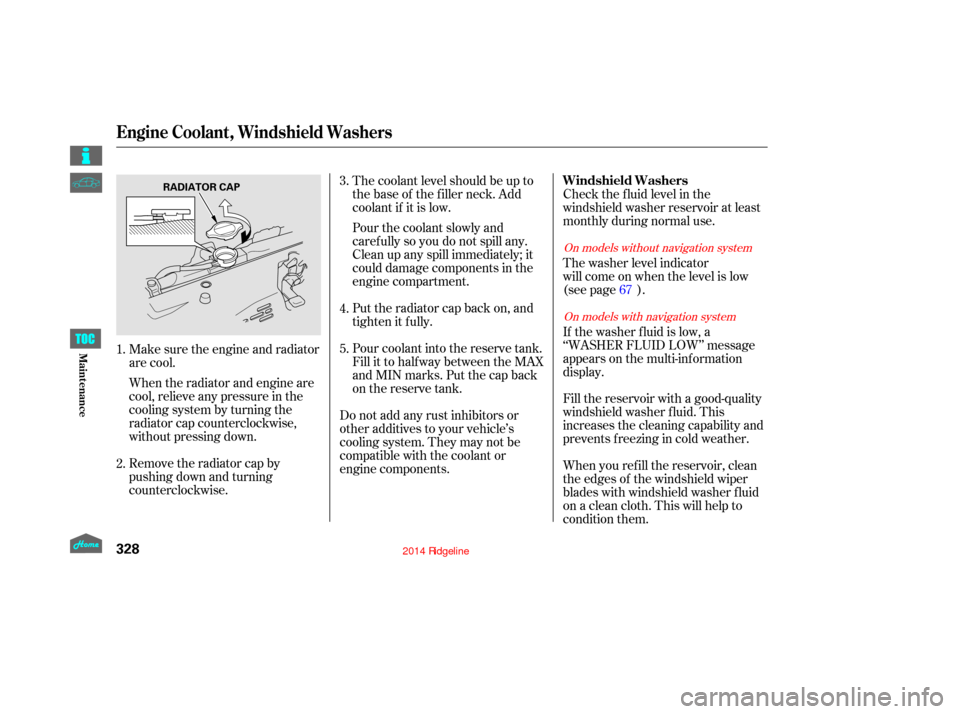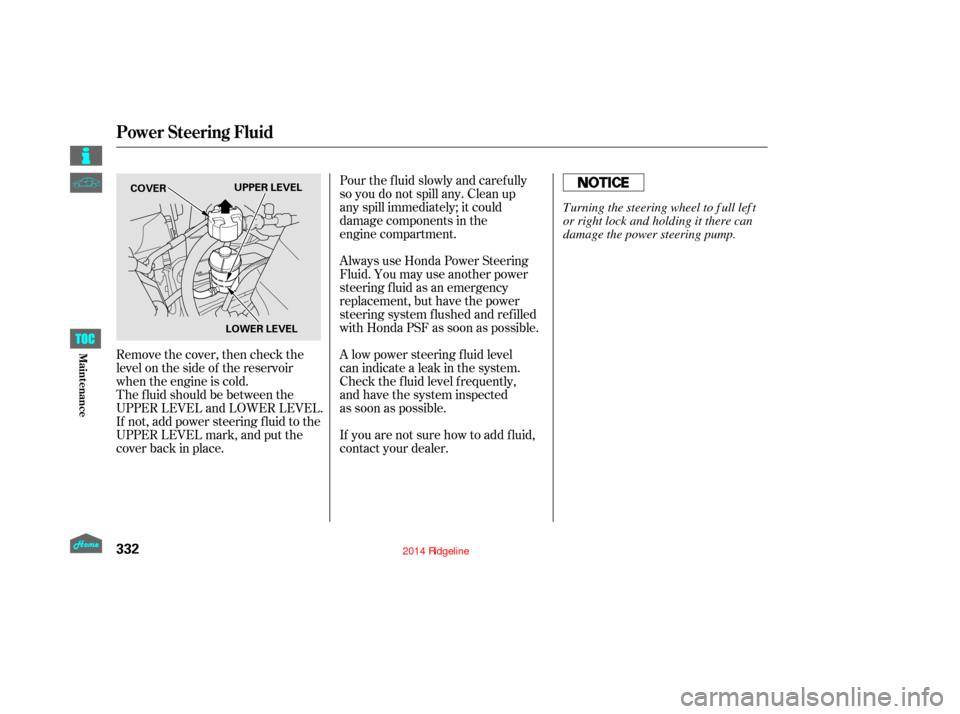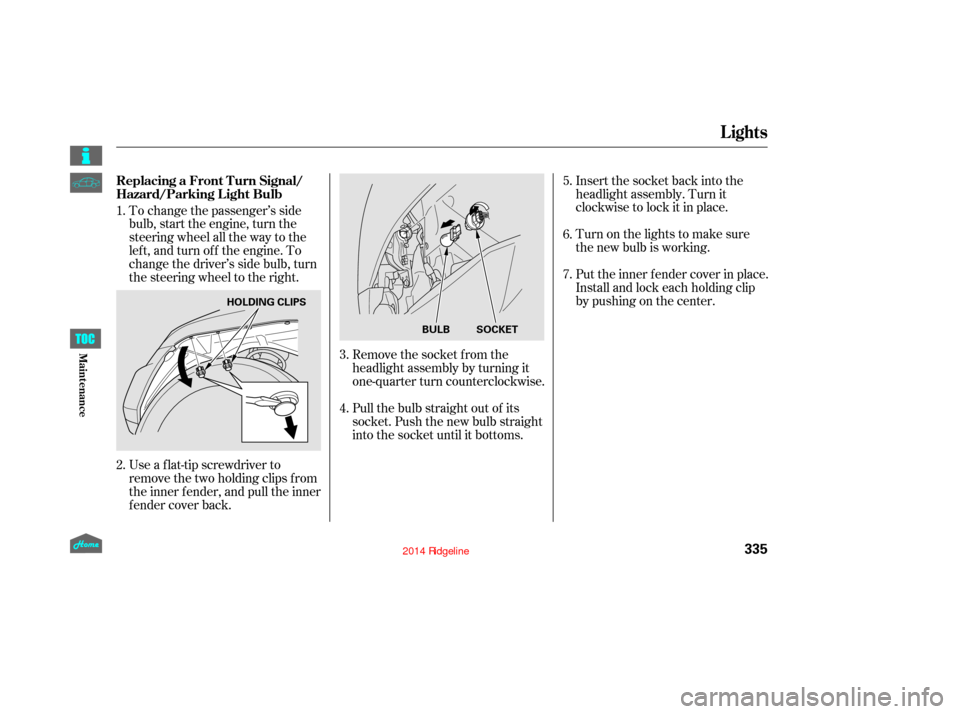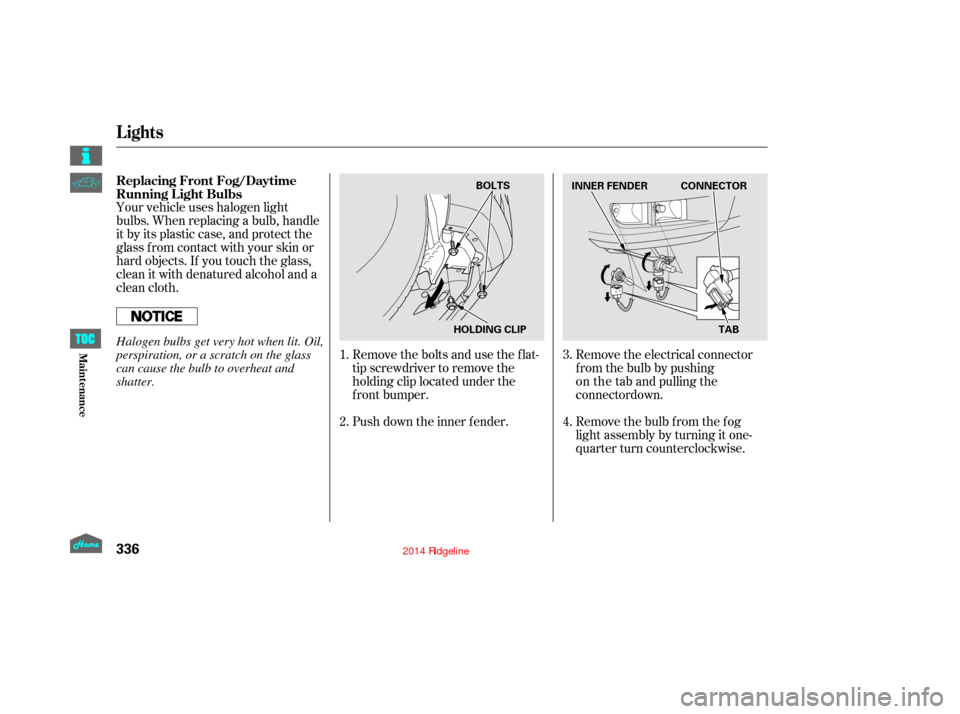2014 HONDA RIDGELINE lock
[x] Cancel search: lockPage 293 of 422

Always steer moderately
when you are braking hard. Severe
or sharp steering wheel movement
can still cause your vehicle to veer
into oncoming traffic or off the road. such as trying to take a
corner too fast or making a
sudden lane change. Always drive
at a safe speed for the
road and weather conditions. It only helps with the
steering control during braking.
If the ABS indicator and the brake
system indicator come on together,
and the parking brake is f ully
released, the EBD system may also
be shut down.
Test your brakes as instructed on
page
.If the brakes f eel normal,
drive slowly and have your vehicle
repaired by your dealer as soon as
possible. Avoid sudden hard braking
which could cause the rear wheels to
lock up and possibly lead to a loss If this happens, you will also see
the ‘‘CHECK ABS SYSTEM’’ and
‘‘CHECK BRAKE SYSTEM’’
messages on the multi-information
display.
on loose or
uneven surfaces, such as gravel
or snow, than a vehicle without
anti-lock. When VSA activates, you may notice
that the engine does not respond to
the accelerator in the same way it
does at other times. There may also
be some noise from the VSA
hydraulic system. You will also see
the VSA system indicator blink. The vehicle stability assist (VSA)
system helps to stabilize the vehicle
during cornering if the vehicle turns
more or less than desired. It also
assists you in maintaining traction
while accelerating on loose or
slippery road surf aces. It does this
by regulating the engine’s output and
by selectively applying the brakes.
The VSA system cannot enhance the
vehicle’s driving stability in all
situations and does not control your
vehicle’s entire braking system. It is
still your responsibility to drive and
corner at reasonable speeds and to
leave a sufficient margin of safety.
374
On models with navigation system
Important Saf ety Reminders
A BS cannot prevent a loss of
stability. A BS will not prevent a skid that
results f rom changing direction
abruptly, A BS does not reduce the time or
distance it takes to stop the
vehicle.
A vehicle with A BS may require a
longer distance to stop
A nti-lock Brakes (A BS), Vehicle Stability A ssist (VSA), aka Electronic Stability Control (ESC), System
288
12/08/09 16:37:06 31SJC670_295
Driving
of control.
Page 308 of 422

If the vehicle’s tires slip when
retrieving a boat f rom the water,
shif t to f irst gear, and turn on VTM-4
lock (see page ). Disengage
VTM-4 lock as soon as the boat is
out of the water to prevent damage
to the VTM-4 system.
Your vehicle is not designed to be
towed behind a motor home. If your
vehicle needs to be towed in an
emergency, see page .
Do not park on an incline unless it is
unavoidable. If you must park on an
incline, f ollow the steps below to
help prevent the vehicle and trailer
f rom rolling and possibly injuring
someone.
Turn the f ront wheels toward the
curb on a downhill, and away f rom
the curb on an uphill.
With the f oot brake f ully pressed,
have someone place wheel chocks
on the downhill side of the vehicle
and trailer wheels.
Firmly apply the parking brake
bef ore you put the transmission in
Park. This keeps the vehicle f rom
putting pressure on the parking
mechanism in the transmission. It
also makes it easier to move the
shif t lever out of Park when you
want to drive away.
Crosswinds and air turbulence
caused by passing trucks can disrupt
your steering and cause the trailer to
sway. When being passed by a large
vehicle, keep a constant speed, and
steer straight ahead. Do not try to
make quick steering or braking
corrections.
When parking on level ground,
f ollow all normal precautions (see
page ) including putting the
transmission in Park, and f irmly
setting the parking brake. Always drive slowly and have
someone guide you when backing up.
Grip the of the steering wheel,
then turn the wheel to the left to get
the trailer to move to the lef t. Turn
the wheel to the right to move the
trailer to the right.
1.
2.
3.
284 274
381
bottom Ret rieving a Boat
Handling Crosswinds and Buf f et ing
Parking
Backing Up
Towing a Trailer
Towing Your Vehicle
303
12/08/09 16:39:15 31SJC670_310
Driving
Page 311 of 422

Forbettertractiononallsurfaces,
accelerate slowly and gradually build
up speed. If you try to start too fast
on wet soil, mud, snow, or ice, you
might not have enough traction to
get underway, and you may dig
yourself a hole. Starting with the
shif t lever in second (2) gear will
help you have a smoother start on
snow or ice.
Keep in mind that you will usually
need more time and distance to
brake to a stop on unpaved surf aces.
Avoid hard braking. Do not ‘‘pump’’
the brakes; let the anti-lock braking
system pump them f or you.Your vehicle is not equipped with
undercarriage guards to protect key
components, so take care to avoid
rocks, tree stumps, and other
obstacles in your path.
Because your vehicle has a higher
center of gravity than a conventional
passenger vehicle, driving a wheel
over a tall object, or allowing a wheel
to drop into a deep hole, can cause
your vehicle to tip or roll over.
If you can’t clearly see all conditions
or obstacles on a slope, walk the
slope bef ore you drive on it. If you
have any doubt whether or not you
can saf ely drive on the slope, don’t
do it. Find another route.
If you are driving up a hill and f ind
that you cannot continue,
. Your vehicle could roll
over. Slowly back down the hill,
f ollowing the same route you took up
the hill.
do not try to
turn around
A ccelerating and Braking A voiding ObstaclesDriving on Slopes
Of f -Highway Driving Guidelines
306
12/08/09 16:39:37 31SJC670_313
Driving
Page 312 of 422

The banks and surf ace under the
water provide good traction. The
water may hide hazards such as
rocks, holes, or mud.
Before driving through water, stop,
get out if necessary, and make
sure that:
If you decide it is saf e to drive
through water, choose a suitable
speed, and proceed without shif ting,
changing speeds, stopping, or
shutting of f the engine.
Do not try to cross water at high
speeds, as this may cause severe
damage to the cooling system or
result in loss of control.
After driving through water, test
your brakes. If they got wet, gently
‘‘pump’’ them while driving slowly
until they operate normally.
If the water is deeper than the wheel
hubs, some additional service may
be required. This service is not
covered by your warranties.
The water is not f lowing too f ast.
Deep rushing water can sweep you
downstream. Even very shallow
rushingwatercanwashthe
ground f rom under your tires and
cause you to lose traction and
possibly roll over. The banks are sloped so you can
drive out. The water is not deep enough to
cover your wheel hubs, axles, or
exhaust pipe. You could stall and
not be able to restart your engine.
The water can also damage
important vehicle components. If you get stuck, and cannot get
unstuck with the VTM-4 system,
engage the VTM-4
Lock (see page
), and carefully try to go in the
direction (f orward or reverse) that
you think will get you unstuck. Do
notspinthetiresathighspeeds.It
will not help you get out and may
cause damage to the transmission or
VTM-4 system.
If you are still unable to f ree yourself ,
your vehicle is equipped with f ront
and rear tow hooks designed f or this
purpose (see page ). 274
381
CONT INUED
If You Get Stuck
Crossing a Stream
Of f -Highway Driving Guidelines
307
12/08/09 16:39:47 31SJC670_314
Driving
Page 333 of 422

Make sure the engine and radiator
are cool.
When the radiator and engine are
cool, relieve any pressure in the
cooling system by turning the
radiator cap counterclockwise,
without pressing down.
Remove the radiator cap by
pushing down and turning
counterclockwise.The coolant level should be up to
the base of the f iller neck. Add
coolant if it is low.
Pourthecoolantslowlyand
caref ully so you do not spill any.
Clean up any spill immediately; it
could damage components in the
engine compartment.
Put the radiator cap back on, and
tighten it fully.
Pour coolant into the reserve tank.
Fill it to half way between the MAX
and MIN marks. Put the cap back
on the reserve tank.
Do not add any rust inhibitors or
other additives to your vehicle’s
cooling system. They may not be
compatible with the coolant or
engine components. Check the f luid level in the
windshield washer reservoir at least
monthly during normal use.
Fill the reservoir with a good-quality
windshield washer fluid. This
increases the cleaning capability and
prevents freezing in cold weather. The washer level indicator
will come on when the level is low
(see page
).
If the washer fluid is low, a
‘‘WASHER FLUID LOW’’ message
appears on the multi-information
display.
When you ref ill the reservoir, clean
the edges of the windshield wiper
blades with windshield washer f luid
on a clean cloth. This will help to
condition them.
3.
4.
5.
1.
2. 67
On models without navigation system
On models with navigation system
Windshield Washers
Engine Coolant, Windshield Washers
328
RADIATOR CAP
12/08/09 16:42:27 31SJC670_335
Maint enance
Page 337 of 422

Pour the fluid slowly and carefully
so you do not spill any. Clean up
any spill immediately; it could
damage components in the
engine compartment.
A low power steering fluid level
can indicate a leak in the system.
Check the fluid level frequently,
and have the system inspected
as soon as possible. Always use Honda Power Steering
Fluid. You may use another power
steering f luid as an emergency
replacement, but have the power
steering system f lushed and ref illed
with Honda PSF as soon as possible.
If you are not sure how to add f luid,
contact your dealer.
Remove the cover, then check the
level on the side of the reservoir
when the engine is cold.
The f luid should be between the
UPPER LEVEL and LOWER LEVEL.
If not, add power steering f luid to the
UPPER LEVEL mark, and put the
cover back in place.
Power Steering Fluid
332
LOWER LEVEL
COVER
UPPER LEVEL
Turning the steering wheel to f ull lef t
or right lock and holding it there can
damage the power steering pump.
12/08/09 16:42:54 31SJC670_339
Maint enance
Page 340 of 422

Remove the socket from the
headlight assembly by turning it
one-quarter turn counterclockwise.
Pull the bulb straight out of its
socket. Push the new bulb straight
into the socket until it bottoms.Turn on the lights to make sure
the new bulb is working.
Put the inner f ender cover in place.
Install and lock each holding clip
bypushingonthecenter. Insert the socket back into the
headlight assembly. Turn it
clockwise to lock it in place.
To change the passenger’s side
bulb, start the engine, turn the
steering wheel all the way to the
lef t, and turn of f the engine. To
change the driver’s side bulb, turn
the steering wheel to the right.
Use a f lat-tip screwdriver to
remove the two holding clips f rom
the inner f ender, and pull the inner
f ender cover back. 5.
6.
1.
2. 3.
4.7.
Replacing a Front T urn Signal/
Hazard/Parking L ight Bulb
Lights
335
HOLDING CLIPS
BULB SOCKET
12/08/09 16:43:18 31SJC670_342
Maint enance
Page 341 of 422

Your vehicle uses halogen light
bulbs. When replacing a bulb, handle
it by its plastic case, and protect the
glass from contact with your skin or
hard objects. If you touch the glass,
clean it with denatured alcohol and a
clean cloth.Push down the inner f ender.Remove the electrical connector
from the bulb by pushing
Remove the bulb f rom the f og
light assembly by turning it one-
quarter turn counterclockwise.
Remove the bolts and use the flat-
tip screwdriver to remove the
holding clip located under the
f ront bumper.
2. 3.
4.
1.
Replacing Front Fog/Daytime
Running L ight Bulbs
Lights
336
BOLTS
INNER FENDER
TAB
HOLDING CLIP CONNECTOR
Halogen bulbs get very hot when lit. Oil,
perspiration, or a scratch on the glass
can cause the bulb to overheat and
shatter.
12/08/09 16:43:26 31SJC670_343
Maint enance
on the tab and pulling the
connector down.